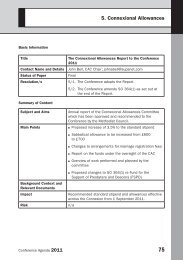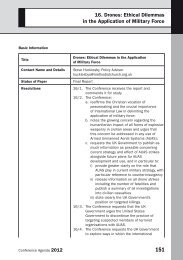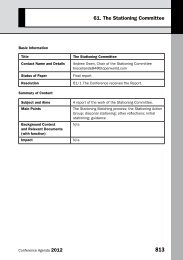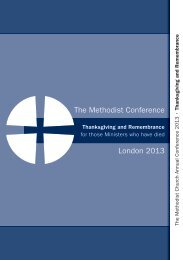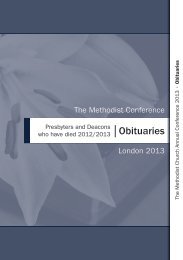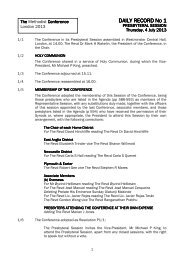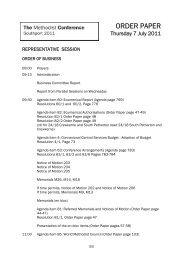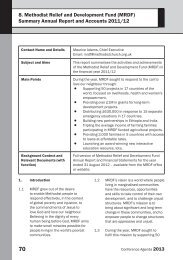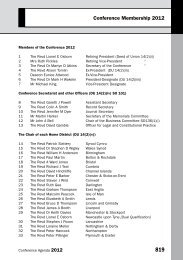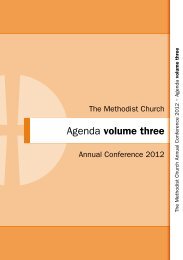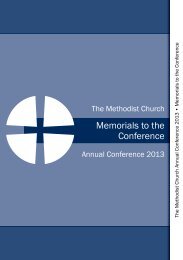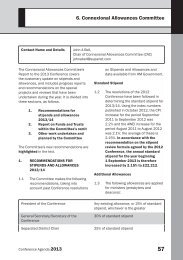Agenda Volume 2 - Methodist Conference
Agenda Volume 2 - Methodist Conference
Agenda Volume 2 - Methodist Conference
Create successful ePaper yourself
Turn your PDF publications into a flip-book with our unique Google optimized e-Paper software.
35. Larger than Circuit<br />
380<br />
questions for districts. Initially<br />
these were about how to facilitate<br />
and support the circuits in their<br />
development, and a focused<br />
and funded role to support and<br />
encourage this process of change<br />
(ie through District Development<br />
Enablers (DDEs)) was offered. Now,<br />
the issues are about the challenges<br />
being experienced by circuits which<br />
have been substantially reconfigured.<br />
Not surprisingly, questions arise as<br />
to how a district’s structures and<br />
functions can appropriately support<br />
the increased variety of types of<br />
circuit, from those which are and<br />
are likely to remain small to those<br />
which contain very large numbers of<br />
churches and ministers spread over<br />
a wide geographical area. But these<br />
reconfigured circuits also offer some<br />
very helpful thinking which we do well<br />
to remember: the fact that often they<br />
require some form of sub-grouping<br />
of local churches, into eg sections<br />
or mission areas, means that work<br />
is done at the most appropriate<br />
level, based not on formal structures<br />
but upon relationships – a truly<br />
connexional approach.<br />
e. Belonging together<br />
52. Going deeper than the organisational<br />
developments just described, there<br />
is a more profound question.<br />
53. It is perhaps posed more acutely<br />
when we look at two more obviously<br />
diverse groupings within the church.<br />
First, how do we ‘belong together’<br />
and reflect the aspirations and<br />
connexional understanding of<br />
<strong>Methodist</strong> congregations in our midst<br />
whose first language is not English<br />
and whose church culture developed<br />
elsewhere in the world <strong>Methodist</strong><br />
family? And secondly, how do we<br />
relate our traditional ways of ordering<br />
our life to the abundant growth of<br />
ventures such as Fresh Expressions<br />
or VentureFX activity?<br />
54. However, it is a question for the<br />
whole church. As explained above,<br />
and implicit in this whole report,<br />
in its explorations the working<br />
party has worked within the<br />
ecclesiological understandings about<br />
connexionalism expressed in the<br />
various major reports brought to the<br />
<strong>Conference</strong> over recent years and<br />
most particularly the foundational<br />
document Called to Love and Praise.<br />
There is another important strand<br />
which that document also identifies<br />
in <strong>Methodist</strong> ecclesiology: “the<br />
conviction that the Church should<br />
be structured for mission, and able<br />
to respond pragmatically, when new<br />
needs or opportunities arise”. 8 Or,<br />
as the present General Secretary<br />
expressed it in his report to the<br />
<strong>Conference</strong> in 2011: “We are a<br />
connexional Church and from time<br />
to time we revisit how we embody<br />
and expound the nature of our<br />
connexionalism.” 9<br />
8 . Ibid. para. 4.7.1<br />
9 General Secretary’s Report: Contemporary<br />
Methodism: a discipleship movement shaped for<br />
mission, <strong>Conference</strong> <strong>Agenda</strong> 2011, p. 29,.para. 18,<br />
<strong>Conference</strong> <strong>Agenda</strong> 2013



